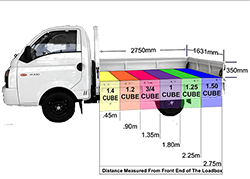Hi, I hope this is the right place to ask my question.
So i have started a new job which requires that i calculate the volume of load bins of courier vans really fast. This is going to be hard for me to explain but here goes.
A customer arrives with a van that has a load bin for example that has a measurement of 2.1m long and 1.63m wide and 0.5m high. Which is the simple part. It is length x width x height which equates to about 1.71m3. But i only need to load 1m3 of aggregate in the bin starting from the back of the van. This very hard to explain. I need to be able to calculate where 1m3 will end on the bin in length, so i can use a tape measure and measure the distance on the bin and then load it with the aggregate. It gets more interesting when the customer only wants a portion of a cube. I found this image on the internet which is exactly what i need and how i need to be able to do it. I tried some of my own formulas but they were all doomed to disaster as my figures ended up way out of the path. Our customers come to collect in a great variety of load bins, from small trailers that are way less than a cube to 15ton flat beds, and i need to need to know really fast where a cube ends or a half cube. Some miracle formula that i can apply like length x height x width divided by total length of bin ( which by the way was one of my disastrous attempts and did not work )
I found this image on the internet which is exactly what i need and how i need to be able to do it. I tried some of my own formulas but they were all doomed to disaster as my figures ended up way out of the path. Our customers come to collect in a great variety of load bins, from small trailers that are way less than a cube to 15ton flat beds, and i need to need to know really fast where a cube ends or a half cube. Some miracle formula that i can apply like length x height x width divided by total length of bin ( which by the way was one of my disastrous attempts and did not work )
I hope i have explained for question clearly, and thanks for any help.
So i have started a new job which requires that i calculate the volume of load bins of courier vans really fast. This is going to be hard for me to explain but here goes.
A customer arrives with a van that has a load bin for example that has a measurement of 2.1m long and 1.63m wide and 0.5m high. Which is the simple part. It is length x width x height which equates to about 1.71m3. But i only need to load 1m3 of aggregate in the bin starting from the back of the van. This very hard to explain. I need to be able to calculate where 1m3 will end on the bin in length, so i can use a tape measure and measure the distance on the bin and then load it with the aggregate. It gets more interesting when the customer only wants a portion of a cube.
 I found this image on the internet which is exactly what i need and how i need to be able to do it. I tried some of my own formulas but they were all doomed to disaster as my figures ended up way out of the path. Our customers come to collect in a great variety of load bins, from small trailers that are way less than a cube to 15ton flat beds, and i need to need to know really fast where a cube ends or a half cube. Some miracle formula that i can apply like length x height x width divided by total length of bin ( which by the way was one of my disastrous attempts and did not work )
I found this image on the internet which is exactly what i need and how i need to be able to do it. I tried some of my own formulas but they were all doomed to disaster as my figures ended up way out of the path. Our customers come to collect in a great variety of load bins, from small trailers that are way less than a cube to 15ton flat beds, and i need to need to know really fast where a cube ends or a half cube. Some miracle formula that i can apply like length x height x width divided by total length of bin ( which by the way was one of my disastrous attempts and did not work )I hope i have explained for question clearly, and thanks for any help.
